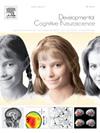不确定性下社会信息使用的发展差异:神经计算方法
IF 4.9
2区 医学
Q1 NEUROSCIENCES
引用次数: 0
摘要
青春期是一个重新定位社会的时期,研究表明,青少年可能比其他年龄组对同伴的影响更敏感。因此,更清楚地了解青少年时期同伴影响的动态和发展尤为重要。在这项研究中,我们比较了青少年(12-18岁)和成年人(22-45岁)社会学习的认知和神经过程,重点关注不确定性如何影响社会信息的使用。参与者完成了一个感知决策任务,在这个任务中,他们可以在看到同伴的估计后修改自己的初步估计。不确定性是通过改变决策前提供的信息量和操纵同伴报告的信心来操纵的。结合无模型分析和贝叶斯计算模型,我们发现,尽管青少年和成年人表现出相似的核心决策机制,但计算模型显示,青少年对自身确定性和同伴信心的变化不太敏感,从而降低了对社会信息使用的影响。功能性核磁共振显示,与成年人相比,青少年对同伴信心变化的神经反应较弱,但对自己信心变化的神经反应较强。然而,当个人信息和同伴信息结合在一起时,这种强烈的反应就不存在了。我们讨论了这些观察结果是如何通过青春期持续的神经发育来解释的,这导致了元认知能力的降低,从而阻碍了精确信号的有效整合。总之,这些发现加深了我们对青少年在不确定性下如何处理社会信息以及这一过程如何随着年龄的增长而演变的理解。本文章由计算机程序翻译,如有差异,请以英文原文为准。
Developmental differences in social information use under uncertainty: A neurocomputational approach
Adolescence is a period of social re-orientation, with studies suggesting that adolescents may be more sensitive to peer influence than other age groups. A clearer understanding of the dynamics and development of peer influence during adolescence is therefore particularly pertinent. In this study, we compared the cognitive and neural processes underlying social learning in adolescents (12–18 years) and adults (22–45 years), focusing on how uncertainty influences social information use. Participants completed a perceptual decision-making task in which they could revise their initial estimate after viewing a peer's estimate. Uncertainty was manipulated by varying the amount of information provided before their decision and by manipulating the peer's reported confidence. Using a combination of model-free analyses and a Bayesian computational model, we found that while adolescents and adults exhibit similar core decision-making mechanisms, computational modeling revealed that adolescents were less sensitive to variations in their own certainty and peer confidence, reducing the effect on social information use. Functional MRI revealed that adolescents showed a reduced neural response to peer confidence variations compared to adults, but exhibited a stronger initial neural response to variations in their own certainty. However, this heightened response was not present anymore when personal and peer information was to be combined. We discuss how these observations might be explained by ongoing neural development during adolescence, leading to reduced metacognitive abilities which hinder the effective integration of precision signals. Together, these findings deepen our understanding of how adolescents process social information under uncertainty and how this process evolves with age.
求助全文
通过发布文献求助,成功后即可免费获取论文全文。
去求助
来源期刊

Developmental Cognitive Neuroscience
NEUROSCIENCES-
CiteScore
7.60
自引率
10.60%
发文量
124
审稿时长
6-12 weeks
期刊介绍:
The journal publishes theoretical and research papers on cognitive brain development, from infancy through childhood and adolescence and into adulthood. It covers neurocognitive development and neurocognitive processing in both typical and atypical development, including social and affective aspects. Appropriate methodologies for the journal include, but are not limited to, functional neuroimaging (fMRI and MEG), electrophysiology (EEG and ERP), NIRS and transcranial magnetic stimulation, as well as other basic neuroscience approaches using cellular and animal models that directly address cognitive brain development, patient studies, case studies, post-mortem studies and pharmacological studies.
 求助内容:
求助内容: 应助结果提醒方式:
应助结果提醒方式:


